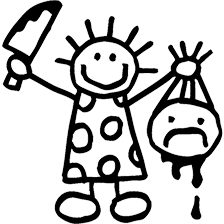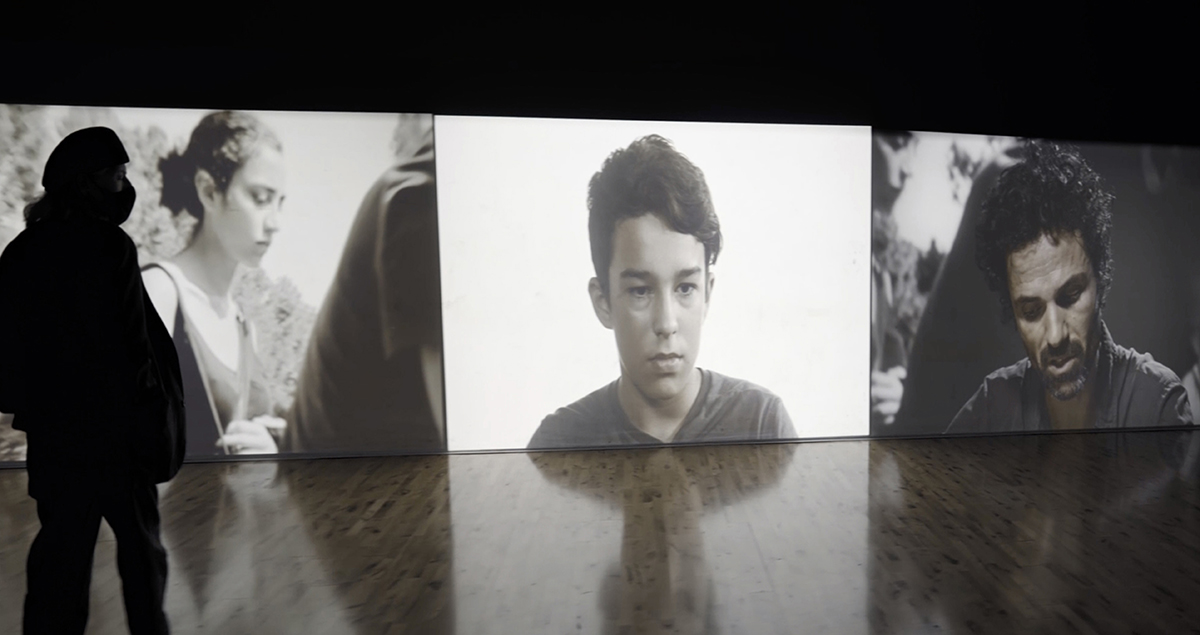session 14
NORA ANCAROLA
With the passing of time, my work has become ever more closely linked to two aspects of reality that particularly concern me: the capacity that artistic languages have to provide new ways of reading small – or large – historical accounts and, at the same time, the observation and use of creative processes and their potential for managing individual and systemic unease as instruments of transformation.
With these two considerations in mind, I have created paintings, photographs, videos and installations in which the images bring into play what is public and what is private in a clear desire to review the statuses to which we adhere. Each project has required a different process as well as a specific technical, procedural and spatial solution. Creating dialogue between image and text has been a recurring theme in my work from the beginning.
I was born in Buenos Aires. I have been living and working in Barcelona since 1978.
presentation
My background as a painter has allowed me to approach videoart with non-linear narrative structures, formulated in layers from within the image and in constant projection, deactivating the habitual strategies of continuity and distanced from the field of cinematography. Carles Hac Mor describes it perfectly in the following text:
“In her videos, videosculptures and video installations she transposes, takes as a starting point and adapts the techniques of painting: textures, thickness, non-thickness, nuances, force, composition and de-composition, veneers and proof, what is said and what is left unsaid, what is shown and what is only suggested.”
As time passes, my projects have begun to take on a more narrative bent, without losing a certain character of superposition in frozen time. Time differentiated from real time is another key element of my work, probably stemming from the world of the static image, although I also consider it to be a vital resource for distancing and counterposing television’s output and the acceleration in media.
The creation of mechanisms that move away from exclusive frontality and that provide a certain amount of interactivity is a strategy I’ve been using more and more as a way to involve the spectator, and at the same time as a way of including the audience in the content and the story.
For this reason, I’ve set up this session as a small presentation space in dialogue with some of the non-linear proposals that form the basis of my work, with finished pieces, but also with anotated fragments.
programme
- SHARED SPACE
These are – although not solely – videographic installations that integrate the spectator within the space. In some cases, there are interactive aspects. There’s a narrative with beginning and end, but it begins when the spectator arrives.
On la_llengua per venir
2020_25 min_three channel videoinstallation + interactive space
Actors: Ina Dunkel, Aurora Vélez, Max Vilalta, Ramon Villegas, Marion Tamme De Aquista
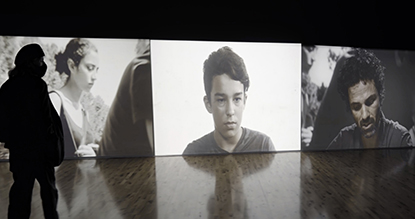
This work contains an exploration of the how the other speaks, building a narrative from texts where the wound of language is present in the actual structure of the story.
In On la_llengua per venir, I paraphrase from Jaques Derrida and Hélène Cixous’ Langue à venir (2004), which investigates the effects of language in relation to sexual difference and matters of postcolonial social exclusion. In my wordplay, with ON (WHERE) I place language in the physical reality of a body, a context, an experience. I also emphasise LA_LLENGUA (THE_LANGUAGE) written in such a way that it remits to lalangue of Lacan and in the PER VENIR (TO COME) as an expectation for the future.
My own experience as an immigrant who wished to integrate through language in a bilingual land brings an important nuance to the work. My aim is to highlight the emotional effects that language causes because of exile.
So, language in exile becomes a symptom, it leaves traces, just like the complex linguistic variations in the literature of authors who have lived through migrations and horrific war experiences, such as Paul Celan, Cixous herself, or Gloria Anzaldúa.
Llengualeche
2021_15 min_four channel videoinstallation
Actors: Max Vilalta and Ramon Villegas
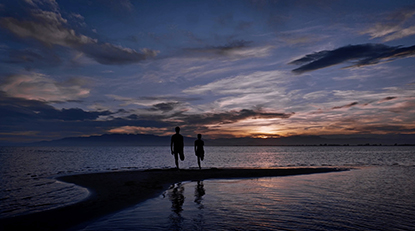
As a result of research from earlier works, in Llengualeche I maintain my focus on panoptic society, the migrant, fragile and precarious bodies that are ignored and established as other even in the most hospitable and welcoming contexts.
The piece reflects the internal struggle produced in the language of immigrants aspiring to balance their need for integration and the preservation of their identity alongside the difficulty in transmitting, such a necessary action in the processes of remembering and forgetting that are in themselves so integral to migrants’ emotions.
The space for the actions is the border area of the banks of the river Ebro, “border incarnate”, where transmission contains the wounds of language produced by the forced migrations caused by the war. The search for that mother tongue – “I only have one language and that is my own”, said Derrida in his book Monolingualism of the Other – is at the heart of the research and exploration. Because, to us the language of the project is a single, Babel-like language, free of rules, that includes diversity in all its forms.
Panòptic_frontera 601
2019_19 min_three channel installation + interactive space + light-texts
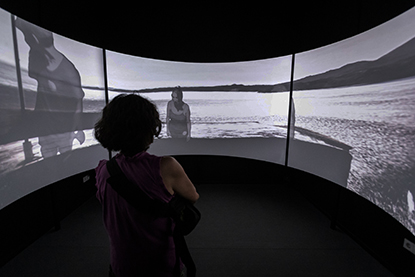
In this project, the German hut – the Gestapo bunker installed in Portbou at the beginning of the World War – is the starting point for alluding to the classist, racist and excluding violence of borders.
This bunker can be found on border 601 between France and Spain. A border with history, a border that even today maintains the silence of violence. This “natural” panopticon condenses its efficiency in the expression of the ‘seeing without being seen’ axis, fundamental to all monitoring systems.
But it all becomes transgressed in these artificial images, constructed with a certain logic of superpositions and with the intention of non-continuity. A natural, bucolic, innocent landscape? Not at all; it’s a landscape that may even include the presence of those who think they are not involved, but perhaps are…
In Panòptic_frontera 601 I’ve tried to create a vis-à-vis with the visitor, but where the other body is missing; we’ll meet in an empty space and we won’t know exactly why we’re there.
Les maletes kafkianes
2018-19_6 min and 12 min in loop_ three channel installation with suitcases
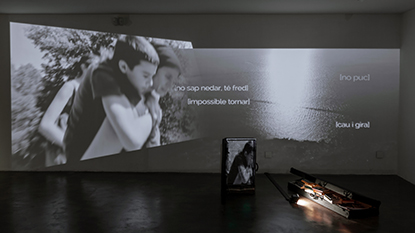
Suitcases as a metaphor for displacement, including forced and uncertain displacements.
Three suitcases – the third never existed – help us understand three stories that make History.
Suitcase 1, Walter Benjamin’s suitcase.
Suitcase 2, Kafka’s suitcase.
Suitcase 3: There are currently around 244 million immigrants in the world. They have no voice; they usually have no suitcase.
This installation carried out a trajectory and a formal transformation as part of its itinerary.
- VIDEOS TO READ
A book of poems on a monochannel video. Each video is part of the reading, as it’s the author themself who recites the accompanying sound. The book must be seen at the same time as the video. The video begins and ends every time a reader picks up or puts down the book.
The works being shown belong to the Babau collection of books published by Edicions1010.

Fissura
2008_18 min
Texts and voice: Carles Hac Mor and Ester Xargay
Darrera el Mur
2007_15:04 min
Texts and voice: Koldo Izagirre
Confabulaciones
2006_9:18 min
Texts and voice: Carlos Vitale
- PAINTINGS THAT BREATHE
These are installations conceived from the collective pictorial imaginary. Fixed shots with infinitesimal movements. One or more channels are configured as paintings on loop.
One characteristic of these installations as a group is their creation based on the appropriation of images from previous works together with new. To some extent, they appear as palimpsests, although each work is organised according to a triple operation: the juxtaposition of images, in layers – this is what suggests a palimpsest – , the conjunction between images through interrelation and the unfolding of these through double or triple reflection using projections, glass, mirrors… A baroque effect that displaces the location of the representation while using different broadcasting channels.

Europa TV
2001_2 min and 4min in loop_two channels
L’Espectador
2001_2 min and 4min in loop_three channels
Esbalaïment de Narcís
2003_5:17 min_installation with mirror
Llençol Sant
2003_2:16 min in loop_installation with water-filled vessels
FLUX CLUB celebrates its 13th season at the Antic Teatre and the 22nd anniversary of its creation in 2000.
This is a fortnightly video programme that reflects the vitality of video creation in Barcelona. It hosts all kinds of sessions with screenings, video performances, and debates offering direct contact between audiences and video creators. The sessions focus on a range of subjects, from monographics of well-known directors to specific themes such as video dance and video poetry, or collective sessions dedicated to emerging authors.
The programme is open to everything currently going on in the field of video in Barcelona, complementing the FLUX Video Auteur Festival with its content and extending its sphere of influence beyond the dates of the festival, which takes place in December.
HABITUAL VIDEO TEAM is a non-profit association that has as its main objective the promotion of activities related to the visual arts, specifically, video art: www.habitualvideoteam.org.
A fundamental area of their work is the organisation of festivals, cycles and video shows, such as the FLUX Video Auteur Festival: www.fluxfestival.org, and the INFLUX Audiovisual Performing Arts Festival: www.influxfestival.org.
Another area of Habitual Video Team’s activity is video documentation of cultural events mainly related to experimental music and poetry performances. In 2012 they launched the SUMMA project in order to convert this audiovisual heritage (more than 1000 recordings) into a non-profit online video archive: www.summa-hvt.org.
